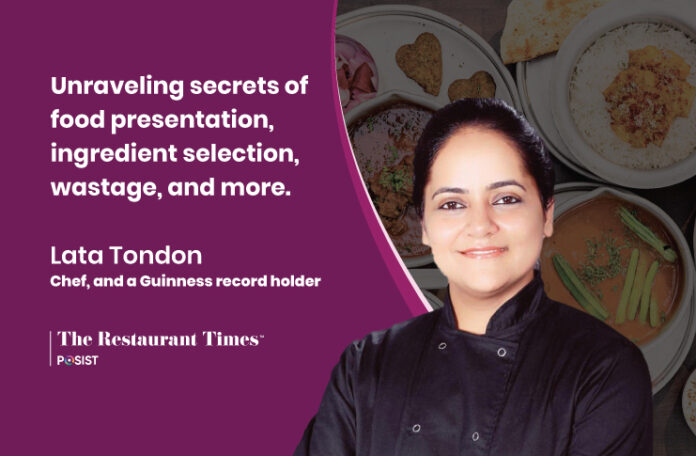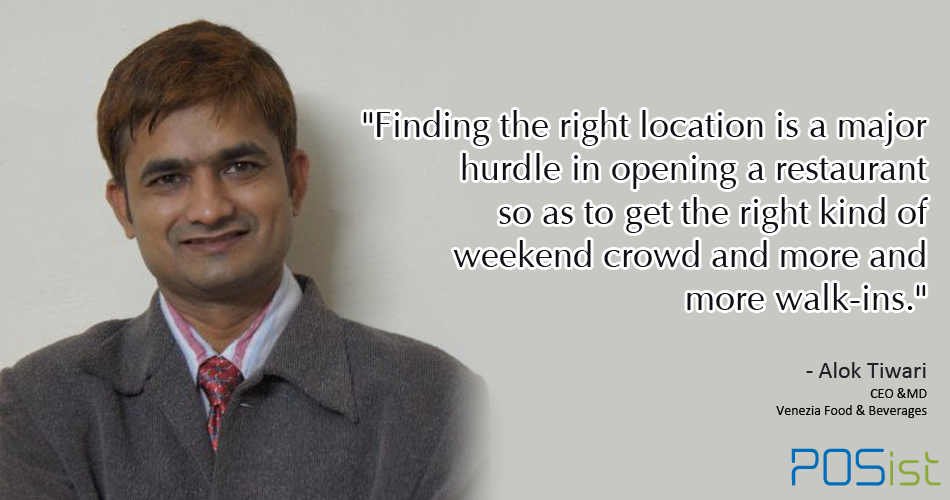Chef Lata Tondon is one of the exemplary women in the food and hospitality industry, holding seven world records for her work as a chef and holds multiple certifications in international cuisine. A true-blue adventurer, she also runs a food expedition wherein she travels across the country in her Thar while exploring and cooking the local cuisines with local ingredients – all by herself in the wild.
In Conversation with Lata Tandon, a Guinness record holder chef
In an exclusive interview with The Restaurant Times, Lata Tandon, a chef and a Guinness Book of world record holder for a nonstop cooking marathon, we talk about her journey as chef, her experience of international cuisines, food presentation, wastage, and more.
TRT – Cooking for a straight 87 hours and 45 minutes might be as hard as it sounds. We are sure a lot of preparation went down and you might have faced challenges as well. Could you please tell us what the journey was like to this achievement?
Lata: I faced a lot of challenges when I started. As a woman, I feel our life is challenging from the beginning itself. We need to prove ourselves for anything we want. Cooking has always been my passion since childhood. I was into it but the challenges of life came along like family, getting married, having a kid, studies, and the responsibilities.
But the passion remained and I went to London for culinary education because I felt I needed that experience. As a 37-year-old woman, following your passion is tough. There are a lot of constraints. I could not take my kids along to the cooking classes.
So, I decided to make a difficult choice to go out of India and enrolled at the Academy of London. I stayed there for 2 years. It was an emotionally challenging time for me.
One fine day, I happened to come across the Guinness office and a wild thought came into my mind – why not cook for a record? During that time, the longest cooking marathon was 48 hours. I thought to myself that 48 hours was possible. Then, I shared this idea with my husband and my brother. They thought I was crazy. They couldn’t understand how someone can cook for 50 hours standing throughout.
If I were to break the record, I needed to stand for 50 hours. The idea was rejected initially. But it remained in my mind and I started practicing while living in London by myself and with my instructor. I started doing gym, meditation, and yoga. And, the next year I proposed that now I was strong enough and can cook for 48 hours. My husband thought I was being crazy again now that the record was 68 hours 30 minutes.
The range to beat it was 70 hours and more. It seemed impossible. My brother had gone to all the doctors and told me that it’s not possible for a human being to stand for 70 hours and cook. It’s not possible. It needs a lot of practice and your body needs a lot of stamina. So, I again practiced and proposed that I will be doing it for 72 hours. My proposal was accepted by Guinness in January 2019 and I decided to make the 3rd of September 2019 to be the D-day so that I can get 6- 7 months for practice.
I had set to achieve the mark of 72 hours but I broke the record by 19 hours more than the previous records, taking it to 87 hours 45 minutes.
TRT – You specialize in multiple international cuisines as well as Indian cuisines. What was it like to master such a diverse portfolio of international cuisines? Also, as a chef, what are the key differences that you want to explain between Indian and international cuisine?
Lata: I am Indian. So, naturally, Indian cuisine was in my blood. I explored Indian cuisine a lot. However, Indian cuisine, in my opinion, is very rustic and it doesn’t have that finesse and versatility. I decided to give it a new twist by fusing the international cuisine with it.
I went to London and learned about different cuisines. There I worked in Italian, Chinese, Japanese, French, and English. It was an altogether different approach to international cuisine. Working and living with the Michelin-level chefs was a masterclass in itself. It was a different experience for me. I was making mistakes but also learning along the way.
Coming to the difference between Indian and international cuisine, every cuisine has its pros and cons. Our Indian curries are amazingly tasty but they are rustic in presentation. If we talk about the French and English cuisine, they are not tasty but they look amazing. So, I found it very fascinating to be able to combine the different qualities, flavors, and textures of these cuisines. The whole concept of designing and plating attracted me. I have watched all episodes of MasterChef Australia and found it inspiring. Chef Warden Andy, whom I met in London during my first year, was the key inspiration for going international for me.
TRT- Could you please tell us more about how major a role food presentation plays?
Lata: It plays a significant role. I recently met some amazing celebrity chefs of India wherein we discussed how Indian cuisine is beautiful and different ideas on plating it so that it sells more.
Because we have realized that if you use an altogether unique way of presenting it, it sells more in the Indian market. The first thing a customer notices is how it is being presented and styled. Being a chef, you have to pay attention to the presentation of food as it impacts the selling quite a bit. So, when it comes to Indian food, presenting it elegantly helps sell it more.
TRT- In one of your recent interviews, you mentioned that your vision is to take unusual hyper-local ingredients and create dishes that can change the limited perception of Indian cuisine at a global level. What do you think about the importance of local ingredients in a cuisine?
Also, what are the key factors one must consider while choosing the perfect ingredient for a recipe?
If they use the premium meat for the customers, they use the normal meat for the staff. If the meat doesn’t get used, we put it in the soups and stocks. This way we never waste anything. What I mean is as a chef, I don’t want to waste anything. So, our focus is always not to waste our ingredients instead of going wild about different sets of ingredients.
If the avocados or blueberries are not being produced locally, then we don’t need them. In my practice, I always select the local and seasonal stuff. For example, if it is the season for mangoes then I would go for it instead of buying strawberries which are also expensive in the off-season.
You might notice that these days restaurants have started designing their recipes around the local and regional produce. Being a chef from Madhya Pradesh, which has a lot of tribal areas, my focus is to explore and reach the interiors of these tribes and learn about their flavors and cooking styles.
I aim to raise more awareness about the tribal cuisines. Also, being a Sindhi, I am writing a book on Sindhi cuisine. The reason is it is dying and I am really worried about losing our legacy and feel that the future generations will not get to experience it if we don’t archive it or make efforts to nurture it.
TRT – Being an expert chef in handling some of the biggest kitchens in the hospitality industry, you always look for new ways to delight your customer with food. We would like to understand your take on recipe development and how do you go about creating authentic recipes?
Lata: Recipe development depends from region to region. If I am opening a restaurant in London, I know for a fact that people there love to eat Indian cuisine. If I were in Indore, I would know that people here are more into street food. So, based on the region, I decide what my menu should look like.
I take into account what kind of clients am I going to entertain, and how easy or difficult it is to develop a recipe. For example, if I need to cook butter chicken for a London local vs an Indian, there would be a lot of difference in the taste palette. So, the steps and the ingredients to be followed would differ keeping in mind the client.
Now, recipe development and menu development are different concepts. The menu is on the paper but the recipe is put together on the table as an experience. So, my focus is always on curating the recipes to promote the menu and the restaurants.
Lata: My time in London taught me about zero wastage and how the dustbins that we keep in the kitchen are supposed to be as empty as possible.
Zero wastage was the target of the head chef because the ingredients that come in regularly help us make money. So, if we have extra salad leaves or carrots or any other vegetable, the peels and leaves would go into making stock. The best of it goes to the customer and the rest of it goes to the staff.
So, everything and anything that was there in the produce, we made sure it was used up in the kitchen and never got wasted.
TRT – How did you bring food and travel together and what has been your experience like traveling across the country as a solo women chef?
Lata: I consider myself a traveler and a very wild one. For a little while, my marriage and kids kept me in a cocoon. I kept myself low while fulfilling the role of a wife, mother, and daughter but I always wanted to travel. I remember driving tractors at the age of 10-12.
When I started my studio kitchen, I aimed to make food an adventure. And I decided to blog about my experiences. I wanted to blog from my kitchen and go on expeditions.
This led me to purchase Thar, an amazing wild car. It can go through any obstacle and rough terrain. Somewhere I feel that That reflects my personality as both of us can go through any difficulty and not be afraid of anything. The Thar is my inspiration to blog about my travel kitchen.
TRT- What is your vision going ahead and any advice for budding restaurateurs and chefs?
Lata: These days, I am writing a book on Sindhi cuisine and I want the younger generation to learn about our legacy from it. It is a responsibility that I carry.
My next project is to go and explore the wild on my Thar. I want to reach the tribes of Madhya Pradesh. I am hoping to collaborate with Madhya Pradesh tourism on this. I am trying my best for this. In case it doesn’t work, I will go anyway.
And, my third project is to search for an amazing restaurant place in Indore where I can make people experience what it is like to eat at the farms.
With cattle and chickens roaming around, and organic vegetables growing in the same space, I want to create a community kitchen-like setup. Of course, the customers will not cook. They are supposed to enjoy and relish the atmosphere. While for the kitchen staff, the cooking experience should be like that of a community kitchen. So I am on a hunt for a green patch in Indore and I want to open this experience for Indorians soon.
As for the advice, I think our food industry has a lot to offer to youngsters if they have that fire in them. If they have a passion for food, they can join the industry and get successful. From a business point of view, the food industry is the backbone of our economy. For youngsters, a lot of employment opportunities exist in this space in India. That said, the industry is better abroad. Indian cuisine is much more respected, valued, and in-demand outside India than in India.

















